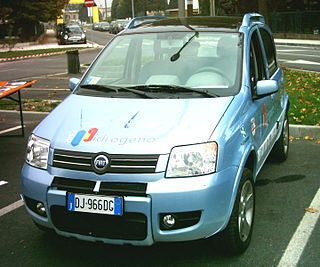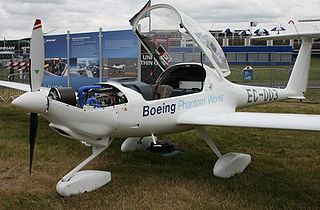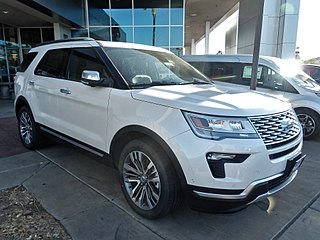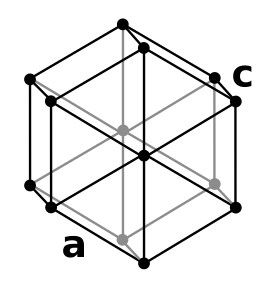
The Honda EV Plus was the first battery electric vehicle from a major automaker with non-lead acid batteries. Roughly 340 EV Plus models were produced and released. The EV Plus was taken out of production in 1999 when Honda announced the release of its first hybrid electric vehicle, the Honda Insight. The EV Plus was made to learn about advanced battery use in an electric car and to meet California Air Resources Board requirements for zero-emission vehicles, the same as the new General Motors EV1. It served as a test bed for the pancake-style motor, electronic control unit, power control unit and the Nickel–metal hydride battery (NiMH) later used in Honda hybrids and developed further in the first Honda FCX Fuel Cell Vehicles made from returned (decommissioned) EV Plus chassis.
Shell Eco-marathon is a world-wide energy efficiency competition sponsored by Shell. Participants build automotive vehicles to achieve the highest possible fuel efficiency. There are two vehicle classes within Shell Eco-marathon: Prototype and UrbanConcept. There are three energy categories within Shell Eco-marathon: battery-electric, hydrogen fuel cell, and internal combustion engine. Prizes are awarded separately for each vehicle class and energy category. The pinnacle of the competition is the Shell Eco-marathon Drivers' World Championship, where the most energy efficient UrbanConcept vehicles compete in a race with a limited amount of energy.
The Buckeye Bullet is a series of experimental electric cars created by Ohio State University students as a joint project with Venturi. The cars are designed to break the land speed record on the Bonneville Speedway, a salt flat just outside Wendover, Utah, United States.

The Lotus Mark VI is the first production car by Lotus Cars. It was introduced by Colin Chapman in 1952 after previously building multiple trials and road racing cars. The heart of the Mark VI is a space frame chassis. Rather than a complete car, it was available to the general public as kit, wherein the customer could install any preferred engine and gearbox, making it eligible for a wider number of formulae.

The F-Cell is a hydrogen fuel cell electric vehicle developed by Daimler AG. Two different versions are known - the previous version was based on the Mercedes-Benz A-Class, and the new model is based on the Mercedes-Benz B-Class. The first generation F-Cell was introduced in 2002, and had a range of 100 mi (161 km), with a top speed of 82 mph (132 km/h). The current B-Class F-CELL has a more powerful electric engine rated at 100 kW (134 hp), and a range of about 250 mi (402 km). This improvement in range is due in part to the B-Class's greater space for holding tanks of compressed hydrogen, higher storage pressure, as well as fuel cell technology advances. Both cars have made use of a "sandwich" design concept, aimed at maximizing room for both passengers and the propulsion components. The fuel cell is a proton exchange membrane fuel cell (PEMFC), designed by the Automotive Fuel Cell Cooperation (AFCC) Corporation.

The Panda Hydrogen is a prototype fuel cell-type hydrogen vehicle based on the Fiat Panda introduced in 2006.

A hydrogen-powered aircraft is an aeroplane that uses hydrogen fuel as a power source. Hydrogen can either be burned in some kind of jet engine, or other kind of internal combustion engine, or can be used to power a fuel cell to generate electricity to power a propeller.

The Toyota FCHV is a current hybrid hydrogen fuel cell vehicle development programme of the Toyota Motor Corporation, which was leased to a limited number of drivers in the United States and Japan beginning in 2002. "FCHV" stands for "Fuel Cell Hybrid Vehicle". A number of prototypes have been produced, up to the latest FCHV-adv ("advanced").

HydroGen3 is an Opel hydrogen fuel cell vehicle used for testing. HydroGen3’s 400-kilometer (250 mi) driving range is the highest of any fuel cell vehicle approved for public roads in Japan. The five seater front-wheel driven prototype is based on the Opel Zafira compact MPV.

Since debuting at the 2007 North American International Auto Show, the restyled North American second generation Ford Focus has been sold by Ford as either a two-door coupe and 4-door sedan — the hatchbacks and wagon were discontinued. The interior was redesigned, including new seats, a new dashboard design with message center atop of the dashboard, ambient lighting, dashboard panels that simulate brushed aluminum, and Ford's voice-controlled Sync audio/Bluetooth system. Also included in the redesign is a support beam behind the dashboard for extra structural rigidity. After the 2010 model year the Ford Focus coupe was discontinued due to slow sales.

The ALFA 40/60 HP is a road car and race car made by Italian car manufacturer ALFA. This model was made between 1913 and 1922 and was designed by Giuseppe Merosi, as were all other Alfas at that time. The 40/60 HP has a 6082 cc straight-4 engine with overhead valves, which produced 70 bhp (52 kW) and its top speed was 125 km/h (78 mph). The race model 40-60 HP Corsa had 73 bhp (54 kW) and a top speed of 137 km/h (85 mph), and it also won its own category in the Parma-Berceto race.
Hydrogen Electric Racing Federation (HERF) is a racing organization for hydrogen fuel cell-powered vehicles, announced on January 10, 2007. HERF was founded by Peter M. DeLorenzo, who also acts as the league's president and CEO.
The Honda FCX is a family of hydrogen fuel cell automobiles manufactured by Honda.

The Mazda Premacy Hydrogen RE Hybrid or Mazda5 Hydrogen RE Hybrid was a hydrogen powered hybrid car produced by Mazda. Later models were also called the Mazda Hydrogen RE Plug in Hybrid. The first car was unveiled in 2005, with an improved version shown at the 2007 Tokyo Motor Show. Mazda planned for the car to enter production and leased a few cars to end users in 2009 in 2010.
The Fiat Phyllis is a prototype fuel cell-type hydrogen vehicle introduced in the International Motor Show Bologna (Italy) held til 14 December 2008. Car's engineers are the Ecole Polytechnic of Turin and the Fiat Research Center who concocted.

The Fiat Phylla concept car was unveiled in 2008 by the Italian car manufacture Fiat. Originally expected to form the basis of a production car in 2010, it remains a concept city car. The Phylla name means "leaves" in ancient Greek.

The Riversimple Urban Car is a conceptual open source hydrogen fuel cell vehicle that was proposed by Hugo Spowers' company, Riversimple, in 2009. Their latest model, the Rasa, was unveiled on 17 February 2016.

Riversimple is a United Kingdom-based car manufacturer of hydrogen-powered fuel cell electric vehicles (FCEVs). It is based in Llandrindod Wells, a town in Wales, where there is a research & development centre and the company's offices. Riversimple was founded by former motorsport engineer and racing driver Hugo Spowers.

The Toyota Mirai is a mid-size hydrogen fuel cell car manufactured by Toyota, one of the first such sedan-like vehicles to be sold commercially. The Mirai was unveiled at the November 2014 Los Angeles Auto Show. As of December 2017, global sales totaled 5,300 Mirais. The top selling markets were the U.S. with 2,900 units, Japan with 2,100 and Europe with 200.

The Hyundai ix35 FCEV or Tucson FCEV is a hydrogen fuel cell electric vehicle developed by Hyundai. It is the first SUV-like vehicles to be sold commercially, as well as the first commercially mass-produced hydrogen fuel cell vehicle in the world. Different versions are known, the previous version was based on the Hyundai Tucson FCEV, and the upcoming model is based on the current ix35 FCEV. The first generation was introduced in 2001, with the Hyundai Santa Fe FCEV, and had a range of 100 miles (160 km), with a top speed of 78 mph (126 km/h).

















